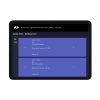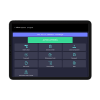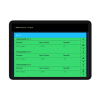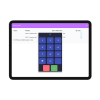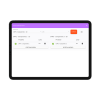 for Industry 4.0
for Industry 4.0
Digitalize your production department with ADeMES!
Why choose ADeMES?
Developed by Trizeta, ADeMES is the right tool for companies that want a production management and control information system:
In cloud
Available in cloud
(public, private, on premise)
User-friendly
and business-oriented
Customizable
Customizable and easily
integrated to ERP
Want ADeMES in your company?
The information flows through the entire company structure, from production to the technical department, up to the manager’s smartphone or tablet
Production
- Intuitive and attractive graphics touchscreen, on PC, tablet or smartphone
- Simplified data entry: work done just in a few quick steps
- Tasks organized by calendar or job
- Access to technical specifications and production data
- Chat communication with the technical department
- Non-conformities, downtime and production waste management
- Check and edit bill of materials at production time

Technical Office
- Accessible from anywhere
- Production orders import from ERP and/or manual input
- Production progress monitoring
- Activities, machinery and operators scheduling in production
- Loading of machinery specifications through:
- CAD or PDF technical drawings
- photos taken from production
- detailed product data sheets
- processing video tutorials
Head of Operations
- Check the OEE (Overall Equipment Effectiveness) of machines and the performance of operators
- Visual access to the summary of all activities
- Production progress data
- Waste monitoring in terms of rejects, errors, downtime
- Management of holiday and leave requests sent by operators through ADeMES
Head of Operations
- Check the OEE (Overall Equipment Effectiveness) of machines and the performance of operators
- Visual access to the summary of all activities
- Production progress data
- Waste monitoring in terms of rejects, errors, downtime
- Management of holiday and leave requests sent by operators through ADeMES
What does ADeMES give you better than other MES?
The system is accessible from any device with a web browser.
In addition, ADeMES is integrated with ADeAI, the artificial intelligence system that supports activity scheduling based on specific production parameters:
machine availability, operator availability, product type and control of machine changeover/setup times
PRODUCTION
All production activities are carried out from smartphones, rugged Android tablets or from a PC equipped with a standard browser placed in a totem or near the processing machine.
blank
Quick start/stop/pause button activity
The button enables quick start, pause and resume of the activity. This ensures real-time monitoring of the activities, without entering the times at the end of the day.

Phase closure button
The operator can pause an activity but can also declare it closed: this does not prevent him from entering further times or carrying out other activities.
blank
Estimation execution times
You can enter a provisional figure for the hours of each activity, so that you can then check if the work will have been done on time.
Changing of working hours
The operator enters, modifies and deletes working times manually. In particular, for activities that do not use the start and stop buttons, this function is the mode for entering working times. The times are managed without constraints, as in a paper report.
Type of time worked
The operator matches one or more vouchers to each reported time record (e.g. “travel time”), differentiating the time of a job on the basis of what is to be recorded (e.g. the time spent on a trip may need to be charged differently from the time actually worked).
blank
Adding notes to activities
Operators enter processing notes that are collected at the end of the work process (reports, details, justifications for any delays in processing). Each note shows the author and the time when it was entered and linked to the specific activity.
Team activity management
When the operator selects the “Task in team” flag, he starts the task time for the whole team and every action performed is automatically replicated for everyone. You can choose a team leader who enters everyone’s times and tasks, but you can also prevent the rest of the team from changing the times, leaving this authority only to the team leader.
PRODUCTION
All production activities are carried out from smartphones, rugged Android tablets or from a PC equipped with a standard browser placed in a totem or near the processing machine.
blank
Quick start/stop/pause button activity
The button enables quick start, pause and resume of the activity. This ensures real-time monitoring of the activities, without entering the times at the end of the day.

Phase closure button
The operator can pause an activity but can also declare it closed: this does not prevent him from entering further times or carrying out other activities.
blank
Estimation execution times
You can enter a provisional figure for the hours of each activity, so that you can then check if the work will have been done on time.
Changing of working hours
The operator enters, modifies and deletes working times manually. In particular, for activities that do not use the start and stop buttons, this function is the mode for entering working times. The times are managed without constraints, as in a paper report.
Type of time worked
The operator matches one or more vouchers to each reported time record (e.g. “travel time”), differentiating the time of a job on the basis of what is to be recorded (e.g. the time spent on a trip may need to be charged differently from the time actually worked).
blank
Adding notes to activities
Operators enter processing notes that are collected at the end of the work process (reports, details, justifications for any delays in processing). Each note shows the author and the time when it was entered and linked to the specific activity.
Team activity management
When the operator selects the “Task in team” flag, he starts the task time for the whole team and every action performed is automatically replicated for everyone. You can choose a team leader who enters everyone’s times and tasks, but you can also prevent the rest of the team from changing the times, leaving this authority only to the team leader.
PROCESSING SPECIFICATIONS
ADeMES improves production management by eliminating paper documents that were previously mandatory in order to carry out activities, such as technical data sheets, reports on the use of materials and equipment, and vehicle data sheet management.
blank
Product data sheets
Each item has its own technical data sheet that you can see through a specific ADeMES button: this sheet is personalized and completes the information necessary for production without adding paper attachments.
Equipment management
A planned activity is associated with the equipment to be used and its status: the office in charge guarantees continuous monitoring.
blank
Products used in the phases
Products used within an activity are reported by declaring the quantities used in order to be able to work. Consequently, the product can be added to the customer report.
The reporting of these products allows the relevant office to carry out stock unloading.
Vehicles management
Within ADeMES, the operator indicates the vehicle used for transport. Routine checks (lights, oil, fuel tank, etc.) can also be carried out to indicate any anomalies and ensure constant monitoring and maintenance.
blank
Bill of Materials
Imported from the ERP, the BOM of the product is provided for consultation to production and allows the parts required for the different processes to be displayed. As the BOM is populated automatically, there is no need to supplement it with attached paper sheets: the system will read the BOM directly from the company ERP.
Definition of sub-activities and related activities
The operator declares the activities actually carried out and, as part of a planned activity, specifies further preparatory or related activities to be carried out.
Product waste measurement
For each work phase, the operator sets differentiated types of waste, specifying the reason why the parts were discarded.
PROCESSING DATA COLLECTION
ADeMES offers several ways of collecting production data, both operator and machine times and quantities of semi-finished or finished products. Several counting modes are available to adapt to your company’s needs.
blank
Automatic counter
The operator uses a piece counter which automatically transfers the semi-finished or finished product; he can also make a reversal at the touch of a button.
Unloading of raw materials
Through ADeMES, the operator declares which components are loaded into the machine for working (raw materials and/or semi-finished products with the relative batches/records loaded into the machine to perform the working phases).
If you want to track the entire production lot and lots of raw materials as well as semi-finished products, the machine loading allows you to define in the phase which materials are used and with which lots. In addition, the operator selects the materials and lots available in a particular warehouse.
black
Finished or semi-finished product deposits from the production stage
The operator makes deposits of finished or semi-finished products from ADeMES at the production stage, declaring the number of compliant pieces produced. The production deposit shows the pieces produced in the warehouse.
black
Customer report
The device generates an intervention report to be signed by the customer, summarising the work, the time and activities carried out, as well as the products used and the people involved. Thanks to this tool, the paper report is eliminated for all interventions at the customer’s premises.
DEFINITION OF COSTS AND STATISTICS
The main purpose of ADeMES is to value the recorded costs: machine, operator and material costs. A precise costing viewpoint for accurate production control.
blank
Cost of operations
ADeMES defines remuneration by contract type and maintenance of historical remuneration, and consequently valorises labour costs.
Definition of maintenance times
Thanks to this function of ADeMES, you will have a more correct planning of maintenance that affects the scheduling of orders.
blank
Cost of products
ADeMES also determines the standard costs of products, so that it can add value to the final product and get a first indicator of the cost of machining. This cost is recorded both for products loaded on the machine for machining and for those listed in the bill of materials, but also for those declared in the report and in the planned activities.
Cost of machinery
The back office defines the business costs for machinery according to its use.
blank
Plant definition
ADeMES presents a mapping of the machines in the plant and the planning follows the scheduling of the machines. The machines are associated with the machining phases and these with the operators, defining limits for scheduling purposes.
Machines can also be declared temporarily out of service by highlighting this fact in the schedule, so that maintenance work can be rescheduled.
Hourly phase cost
The cost of the stage is added to the cost of the operators and machines, calculating a company cost per hour even if there is no machinery connected.
MANAGEMENT, CONTROL AND OPTIMIZATION OF ACTIVITIES
ADeMES does not just count the finished product: it also allows you to make deposits per pallet or loading unit, unload raw materials when they are loaded into the machine and manage the customer’s signature during delivery and installation.
blank
Downtime justification
The operator declares a work interruption and, for each work phase, defines the different reasons for the interruption: in this way the inefficiency times are collected and the reasons are analysed, allowing a subsequent improvement.
Quality control sheet
The operator accessing ADeMES can define, for each phase, a list of controls to be surveyed or copy the last values surveyed and, if necessary, make changes.
When analyzing the data, cross-referencing the control sheet with the incidents and product non-conformities will reveal the conditions in which certain machine parameters have led to work stoppages or product non-conformities so as to be able to optimize the situation and/or predict certain results.
blank
Activities calendar
With a calendar with bi-weekly visibility,but unlimited scheduling, the different activities to be carried out are introduced and organized and the required resources are assigned to them, monitoring workloads. This eliminates the need for excel sheets for coordinating tasks, and the calendar is fully integrated with the MES so that tasks can be assigned directly.
blank
Statistical groups of phases
In addition to defining phases, ADeMES also sets up groupings (“phase types“) to generate statistical data. Machines and operators are associated with each phase. In addition, a list of phases is defined for each product, so that the relevant phases are created for each production order for a particular product.
INTEGRATION AND INTERCONNECTIONS
ADeMES can connect to the company’s ERP with a bi-directional dialogue to extend its functionality, including real-time information exchange between the office and production.
blank
Warehouse transactions for ERP
The system automatically tracks warehouse transactions according to events: this tracking and the adjustment made by any changes allow the ERP system to keep stock, inventory and also keeps product costs under control.
Connected to ADeWMS
When used in connection with ADeWMS, ADeMES notifies warehouse operators of movements required for the next production operation: the control panel will provide warnings so that movements for supplying the production warehouse and preparing materials (e.g. the unloading of products stored for processing) can be organized in good time.
The dashboard provides graphs to monitor production and the situation of materials in the warehouse.
blank
Messages
Through the use of messages, the back office enters communications with the individual operator or group. The operator receiving the communication can view statistics on the reading rate and replies received.
Holiday and leave management
Employees make requests for holidays and leave through ADeMES. If the back office approves, delivery times automatically appear in the calendar and help planning by highlighting any tasks previously allocated to that employee at times when he or she will be absent.
blank
Manual order entry
Using this function, back office staff can view and edit orders read from ERP and put into production, and can define new orders outside ERP: as a result, production can be managed even without being integrated into the management system.
Integrations
ETL TECHNOLOGY FOR INTERCONNECTION WITH ERP
The full and complete real-time integration of production data from ADeMES with the company’s ERP system allows the manager to be more proactive in how to plan production, manage raw materials and components and optimization.
ADeMES is already integrated with the main ERPs such as:ADeMES is already integrated with the main ERPs such as:
Zucchetti AHR – Infinity – Fluentis – Arca EVolution –
Onda – Navision – Sap R3 – Sap business one
All brands mentioned are the property of their rightful owners.
PRECONFIGURED MODULES FOR CONNECTION TO 4.0 MACHINES
OPC UA
MT-CONNECT
others
The connection of ADeMES to plants, transmission protocols and company information systems has been developed using a modular system that allows a new machine to be connected by developing the module that implements the specific communication protocol.
INTEGRATION WITH SCHEDULING SOFTWARE
ADeMES, in addition to being an ERP interface for production orders, is able to receive planning and scheduling information from the main softwares on the market, automatically allowing the creation of the calendar for the execution of work phases.
Want ADeMES in your company?
Book your demo now
and find out how you can reduce waste in terms of reduced rejects, errors, downtime and unnecessary handling, achieving real savings and complete control of production.





